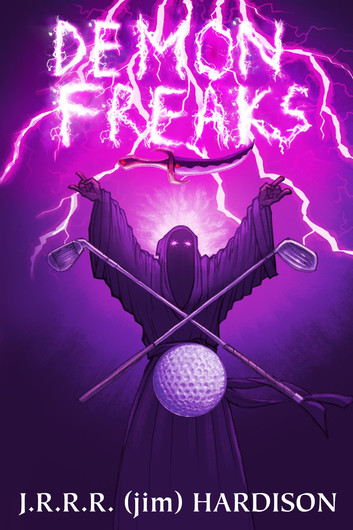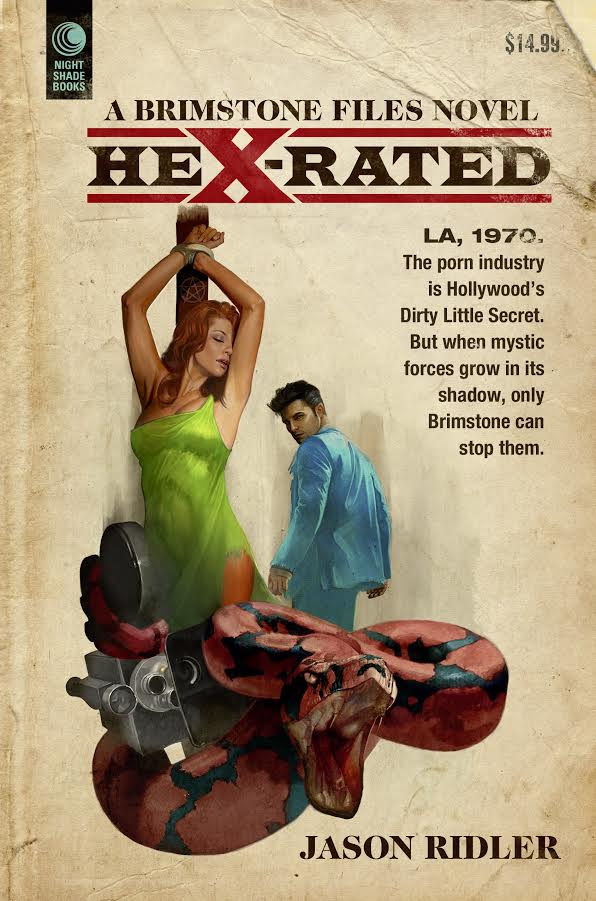
This week on The Scariest Part, my guest is author J.R.R.R. Hardison, whose latest novel is Demon Freaks. Here is the publisher’s description:
It’s the night before the SAT test. The forces of darkness are stirring.
Twin brothers, Bing and Ron Slaughter, know they’ve got to cram like their lives depend on it because their college plans sure do. If they don’t ace the test, they’ll be doomed to spend the rest of their days flipping burgers at the McDonald’s their parents run. That’s why they hatch a plan to meet up with the members of their punk band, the Ephits, spend the night studying at a secluded cabin in the woods, and maybe squeeze in a little jamming. What could go wrong with a brilliant plan like that?
Ancient evil. That’s what.
As a cataclysmic lightning storm rolls in, Bing, Ron and the rest of the Ephits find themselves tangled in a sinister plot to summon a demon. Yes, demons are real. To survive the night, the band must find a malevolent artifact, battle bloodthirsty monsters and stand against the most dangerous and powerful foe humanity has ever faced…the Golfer’s Association.
And now, let’s hear what the scariest part was for J.R.R.R. Hardison:
I do OK in caves, but I don’t love them. It’s an imagination thing. I see possibilities — and I see them more clearly the darker my surroundings get. People get lost in caves, they get trapped in them, drowned in them. They succumb to hypothermia, starvation, bad air. And there are bugs. Troglobites, they call them. I’m not fond of bugs, especially not odd, pale, never-seen-the-light-of-day, bulging-blind-eyed troglobites that might get on you while you can’t see them, or worse, crawl up your nose when you’re dead.
My cave paranoia increases in regards to the safety of other people. That’s not because I’m altruistic. It’s just because I’ve always been pretty lucky, and I feel like I would probably blunder my way out of any subterranean void in which I was lost. But my luck doesn’t extend to other people, like my wife, and I don’t trust my adventurer skills anywhere near enough to believe I could help someone else if something went wrong. If a part of the cave floor gave way and a fellow explorer was hanging over the edge of a lightless abyss, I’m pretty sure their desperate fingers would slip through my clumsy grasp. If underground floodwaters suddenly surged around our necks, it seems like a foregone conclusion that I’d be unable to hold my breath long enough to pull my submerged companion from the icy deluge. And if a falling stalactite pinned a loved one, my well-intentioned but misguided attempt to get help would only result in blind wanderings that would doom her bones to molder in eternal darkness.
All of this is a long way of saying that the scariest part for me in writing Demon Freaks was a sudden silence in the lightless void below the craggy slopes of Mt. St. Helens. I’d decided to visit some caves to prepare for writing the sequence in which two of the central characters are lost in a maze of tunnels and caverns under the clubhouse of the evil Golfers’ Association. For the record, it is a mistake to first research the dangers of caves before physically going into them. Google searching turns up a wide array of stories that all begin by coupling a cave name with the capitalized word disaster, and then end with people dying. The Nutty Putty Cave Disaster, the Mossdale Cavern Disaster, the Cave Creek Disaster…the list goes on. The National Speleological Society also keeps a handy official Journal of Record of Caving Accidents and Safety Incidents that tracks American caving mishaps going back to 1961. The incident entries in this journal are suggestively spare, like, “Fatality. Falling stone,” and “Fatality. Fell into pit.”
After all that reading, it was with some trepidation that I found myself joining various cave tours and forcing myself to hang back just far enough from the group to lose sight of the others. But I never felt really unsafe. Even if I managed to get separated from the group, a guy with a walkie talkie would undoubtedly track me down, or another tour would come along in ten minutes. More often than not, a tour guide would just say, “Sir, please keep up.”
So that’s why I finally decided to visit a nearby cave on an unguided tour with my wife. At 2.5 miles, Ape Cave is the longest continuous lava tube in the continental United States. It’s not a particularly dangerous cave, but as the website ominously informs you, “No cave can ever be considered completely safe.” They urge you to wear warm, heavy clothes (it’s generally about 42 degrees inside), to bring at least two light sources with spare batteries, and to never touch the walls. Never touch the walls? Yes. They harbor “cave slime,” which sounds like it might eat you alive, but is actually just an important food source for the troglofauna — the various creatures that live in the cave.
On the drive out to the cave, I managed to get myself a little worked up about the whole thing, much to my wife’s amusement. This was going to be just the two of us, inside miles of inky dark lava tube, no guide to pull our bacon out of the fire. She was rolling her eyes, but I was almost ready to turn back. Then we arrived at the site and found it swarming with other weekend thrill-seekers and inexperienced cavers. It was not just going to be the two of us.
Yes, it was a very cool way to spend an afternoon. Yes, there were a few heart-racing moments that involved scaling a slick lava wall or scrambling on our bellies through narrow crevices. And yes, I saw a few fearsome cave crickets. But for the most part, it was a pretty tame adventure.
There was one moment we found ourselves alone and out of ear shot of the crowds. We were crouched below a bulging ceiling of blobby black rock in a section of tube about six feet across, and I suggested we turn off our lights to get a better feel for the darkness. The second we flicked our switches, we were blind. In the absence of other sound, my wife’s breathing seemed very loud. Then there was a soft scrabbling and the sound of her breathing stopped. It just stopped.
I listened, strained actually, to catch the whisper of another breath. I reached out, groping for her in the pitch. But there was nothing. Nothing. The eyes of my imagination opened wide and beheld every account of every caving disaster spread before me. “Fatality,” I thought. “Fell into pit.”
And then someone else’s flashlight beam hit us. There was my wife a few feet further than expected, caught in the act of creeping away, a big grin on her face. She insists that she was just “helping” my writing process by holding her breath so that I could feel the full effect of the cave. Me, I don’t believe that for a second.
Demon Freaks: Amazon / Barnes & Noble / Powell’s / IndieBound
J.R.R.R. Hardison: Website / Twitter
Jim has worked as a writer, screen writer, animator and director in entertainment and commercials since graduating from Columbia College of Chicago in 1988. He is the author of The Helm, which YALSA praised as one of 2010’s best graphic novels for young readers, and has directed animated commercial and entertainment projects, including spots for M&M’s, AT&T, and Kellogg’s. He co-founded Character LLC in 2000 and has given story advice to many of the world’s largest brands, such as Target, Verizon, Samsung, McDonalds and Walmart, and has even appeared on NBC’s The Apprentice as an expert adviser on brand characters. Jim lives in Portland, Oregon with his wife, two kids and two dogs. Fish Wielder, Jim’s debut novel, was released in 2016, and Demon Freaks, his second novel, was released in October 2017.
 Dr. Jekyll and Mr. Hyde by Robert Louis Stevenson
Dr. Jekyll and Mr. Hyde by Robert Louis Stevenson



